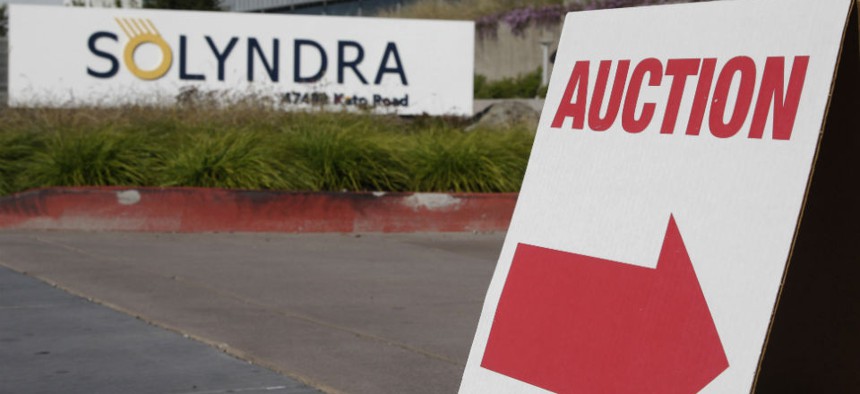
Solyndra received a one half billion dollar loan guarantee from the government before filing for bankruptcy in Sept. 2011. Paul Sakuma/Associated Press
Refighting Solyndra, Issa Rejects Energy’s Claim of Loan Fund Profits
Agency says portfolio is on track to earn $5 billion for taxpayers.
The failed California solar panel maker Solyndra re-entered the news in recent days when the Energy Department touted the overall health of its innovation loan portfolio, drawing a rebuttal from the chairman of the House Oversight and Government Reform Committee.
“In the five years since it issued its first conditional commitment, the [Loan Programs Office] has helped launch the utility-scale photovoltaic solar industry, deploy the next generation of concentrating solar power, revitalize the U.S. nuclear industry, commercialize cellulosic biofuels, and accelerate the growth of advanced and electric vehicle manufacturing,” wrote office Executive Director Peter Davidson in a Nov. 12 blogpost.
Some 20 industry borrowers, he said, have begun repaying their on-average 22-year loans obtained through the Treasury Secretary-supervised Federal Financing Bank, bringing in $3.5 billion in principal and $810 million in interest payments thus far.
Most significantly, Davidson declared that the overall portfolio is expected to earn taxpayers more than $5 billion in total interest payments over the full term of the loans. “However, losses are also inherent in any lending portfolio,” he acknowledged. “And because the mission of LPO is to finance innovative technologies that have never been deployed at commercial scale in the U.S., the program was intentionally designed to carry some level of risk -- and Congress specifically set aside funds to cover those losses when the program was established.”
According to Energy, the overall loses amount to $780 million, or just over 2 percent of the program’s commitments -- less than the interest the program has already earned.
“Through rigorous due diligence and portfolio management by our highly experienced team of professionals,” Davidson wrote, “we expect the portfolio’s financial performance to remain very strong and continue to help move us toward our clean, low-carbon energy future.”
Rep. Darrell Issa, R-Calif., a leading critic of the failed $535 million investment in Solyndra, which he claims was more about helping political donors than advancing energy research, doesn’t buy it. In an email to Government Executive, Issa said, “By the department’s own numbers, interest earned so far barely covers capital losses with billions in loans still left unpaid. Even the department’s new rosy scenario repayment ‘estimates’ for risky outstanding projects lags behind what investors could hope to make on relatively safe investments while dealing with inflation,” Issa said.
“Most disappointing of all, these taxpayer-funded loan projects were supposed to usher in a new era of energy. But energy advancements that have meaningfully helped our economy have been in fracking and other technologies focused on fossil fuels. They have helped lower gas prices and put the United States on the verge of becoming a major energy exporter.”







